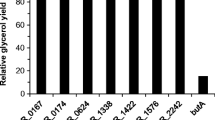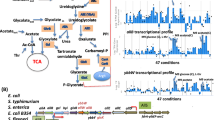Abstract
Glyoxylate, formed as a result of allantoin degradation, is converted by Hyphomicrobium species to glycerate via tartronate semialdehyde. Glyoxylate carboligase and tartronate semialdehyde reductase, the two enzymes involved, are present only in cells grown on allantoin as nitrogen source.
Similar content being viewed by others
References
Attwood, M. M. and Harder, W. 1972. A rapid and specific enrichment procedure for Hyphomicrobium spp. — Antonie van Leeuwenhoek 38: 369–378.
Bellion, E., Bolbot, J. A. and Vash, T. D. 1981. Generation of glyoxylate in methylotrophic bacteria. — Curr. Microbiol. 6: 367–372.
Blackmore, M. A. and Quayle, J. R. 1970. Microbial growth on oxalate by a route not involving glyoxylate carboligase. — Biochem. J. 118: 53–59.
DeWindt, F. E. and Van der Drift, C. 1980. Purification and some properties of hydroxypyruvate isomerase of Bacillus fastidiosus. — Biochim. Biophys. Acta 613: 556–562.
Harder, W. and Attwood, M. M. 1978. Biology, physiology and biochemistry of Hyphomicrobia. — Adv. Microbiol. Physiol. 17: 303–359.
Hedrick, J. L. and Sallach, H. J. 1961. The metabolism of hydroxypyruvate. I. The nonenzymatic decarboxylaton and autooxidation of hydroxypyruvate. — J. Biol. Chem. 236: 1867–1871.
Hermans, J. M. H., Hutten, T. J., Van der Drieft, C. and Vogels, G. D. 1980. Analysis of coenzyme M (2-mercaptoethanesulfonic acid) derivatives by isotachophoresis. — Anal. Biochem. 106: 363–366.
Kortstee, G. J. J. 1980. The homoisocitrate-glyoxylate cycle in pink, facultative methylotrophs. — FEMS Microbiol. Lett. 8: 59–65.
Kortstee, G. J. J. 1981. The second part of the icl− serine-pathway. p. 211–219. In H. Dalton (ed.), Microbial growth on C1 compounds. — Heyden, London.
Lowry, O. H., Rosebrough, N. J., Farr, A. L. and Randall, R. J. 1951. Protein measurement with the Folin phenol reagent. — J. Biol. Chem. 193: 265–275.
Stafford, H. A., Magaldi, A. and Vennesland, B. 1954. The enzymic reduction of hydroxypyruvic acid to D-glyceric acid in higher plants. — J. Biol. Chem. 207: 621–629.
Van der Drift, C., De Windt, F. E. and Doddema, H. J. 1981. Metabolism of allantoin in Hyphomicrobium species. — Antonie van Leeuwenhoek 47: 565–570.
Vogels, G. D. and Van der Drift, C. 1970. Differential analyses of glyoxylate derivatives. —Anal. Biochem. 33: 143–157.
Author information
Authors and Affiliations
Rights and permissions
About this article
Cite this article
van der Drift, C., de Windt, F.E. Glyoxylate conversion by Hyphomicrobium species grown on allantoin as nitrogen source. Antonie van Leeuwenhoek 49, 167–172 (1983). https://doi.org/10.1007/BF00393675
Received:
Issue Date:
DOI: https://doi.org/10.1007/BF00393675




